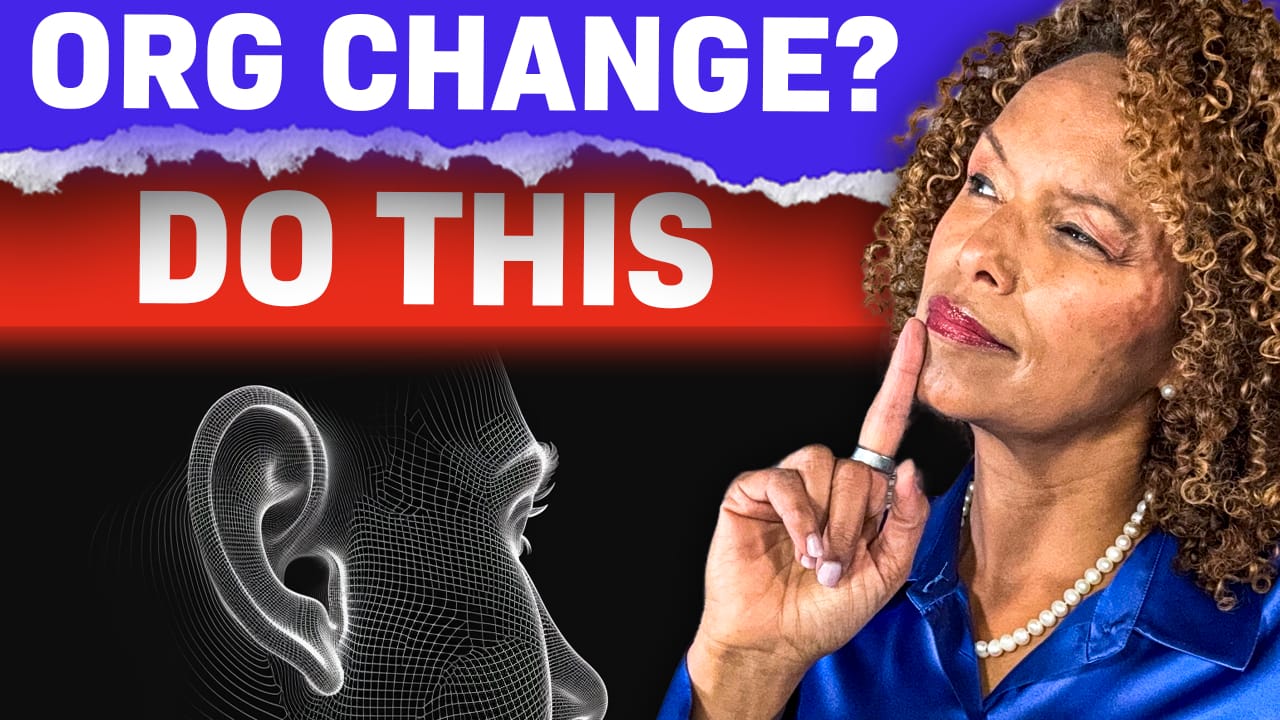Subscribe to the Leadership with Heart Podcast!
Some years ago, I was leading customer experience for an organization, and they decided to reorganize. This is a common thing as organizations look to increase efficiencies, reduce costs, and improve customer experience.
Like with most changes that seem to come on without warning, this change made employees very nervous. What would it mean for their jobs? Would they still have a job? Who would be their new boss?
I was impacted by the reorganization in that my role changed and so did the team who reported to me. I was stressed and feeling like I was a victim of the circumstances while at the same time, I was asked to smile and be the ambassador for all the change. I didn’t realize how badly I felt as a result, and no one bothered to ask how I felt.
I went around and spent a lot of time listening to what was and wasn’t being said about the change in roles and more. I was struggling to feel heard by the leaders in the process.
When thinking through organizational change, leaders must actively listen holistically.
Let us talk more in-depth about the five key steps to active listening and dive deeper into it.
Change within organizations can often be met with uncertainty, resistance, and even fear. And that’s where Active Listening becomes crucial.
Active Listening is not just about hearing what’s being said, but truly understanding the underlying emotions, concerns, and perspectives of others.
Did you know that there are gender gaps related to active listening in the workplace? According to research conducted by my company Employee Fanatix, only 64% of women feel like their supervisor listens to them compared to 76% of men. That leaves plenty of room for improvement.
During periods of change, employees may experience a range of emotions – from excitement to apprehension. As leaders, it’s essential to create an environment where all employees feel heard and valued.
Active Listening involves 5 key steps:
Recognize the Unsaid – To create stronger bonds with your employees and with your customers, you need to learn how to read between the lines with how they are feeling in that moment when you are interacting with them. Once you can recognize that there are things your people are not saying out loud, but feeling beneath the surface, you are ready to seek to understand their truth.
Seek to Understand – When we talk about active listening, the main part of the formula is to be fully present with your team members, to make sure they have your undivided attention. To do that, you need to first start by putting yourself in their shoes and imagining yourself in their situation and how you would feel. In other words, empathize with them. This is critical when we think about organizational change, which usually produces anxiety and apprehension.
Decode – Once you have sought to understand your team member’s unique experience and needs, you need to take time to reflect on what you discovered. You might need to research things a bit or include other departments or team members in evaluating the best next steps to take.
Act – As we think about caring leadership, action is the greatest form of compassion. With consistent check-ins with those team members who may be struggling with personal things, might be burnt out, or just, overall, struggling with the change, you show them that you are truly actively listening to them.
Close the Loop – This step completes the Cycle of Active Listening in that you let those who provided you feedback in the Seeking step know what you plan to do to solve their problem, address their concern, or simply reply to their feedback. Oftentimes, change is uncertain, and many are feeling out of control. When you follow up after feedback, they begin to feel more secure and in control of their experience. The opposite delivers the opposite effect and drastically impacts their well-being.
By actively listening to employees’ concerns and feedback, leaders demonstrate empathy and build trust. This fosters a culture of open communication, where employees feel comfortable expressing their thoughts and ideas. This openness is crucial with organizational change because otherwise, your leaders will have blind spots in their decision-making without those points of view.
When employees feel heard and understood, they are more likely to embrace change, contribute positively to the transition process, and ultimately, drive organizational success. So, whether you’re a leader spearheading a change initiative or an employee navigating organizational transitions, remember the power of Active Listening. It’s not just about what you say, but how well you listen that can make all the difference. It would have made a huge difference for me for sure through the reorganization I experienced.
Podcast
In this episode, Heather explores the critical role of Active Listening in managing organizational change. She highlights the challenges of change, including uncertainty and fear, and emphasizes that Active Listening goes beyond simply hearing to understanding emotions and perspectives. Research shows gender gaps in feeling heard at work and stresses the importance of creating an environment where all employees feel valued. The episode outlines five key steps of Active Listening: Recognize the Unsaid, Seek to Understand, Decode, Act, and Close the Loop. When leaders actively listen to employees, they build trust and foster open communication, leading to greater acceptance of change and organizational success. Whether leading change or navigating transitions, the message underscores the transformative power of Active Listening in creating supportive workplace cultures.
Watch the podcast in video here
Become a Certified Art of Active Listening Facilitator
- Are you overwhelmed with possibilities but don’t know where to start?
- Do you struggle internally to get everyone on the same page?
- Think you don’t have time to create lasting change?
Are you ready to become a high-value leader who champions change in your organization through effective and caring leadership?
Mentions
Connect with Heather on LinkedIn
Let’s connect on social
https://linktr.ee/heatheryounger
About Heather R Younger, J.D., CSP
Heather R Younger, J.D., CSP is a highly sought-after speaker, 2x-TEDx speaker, diversity, equity and inclusion strategist, and contributor to leading news outlets. She is also the Founder and CEO of Employee Fanatix, a leading employee engagement and consulting firm. After over 25,000 employee engagement surveys and years of working with organizations to transform employee engagement, here’s what Heather has seen over and over: When you know how to listen, employees will tell you exactly what they need to bring their full selves to work. Book Heather to speak at your event or organization.
Visit heatheryounger.com or https://www.cmispeakers.com/heather-r-younger for more details.














